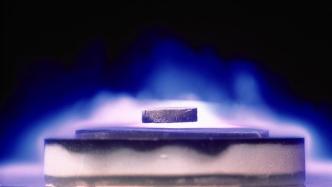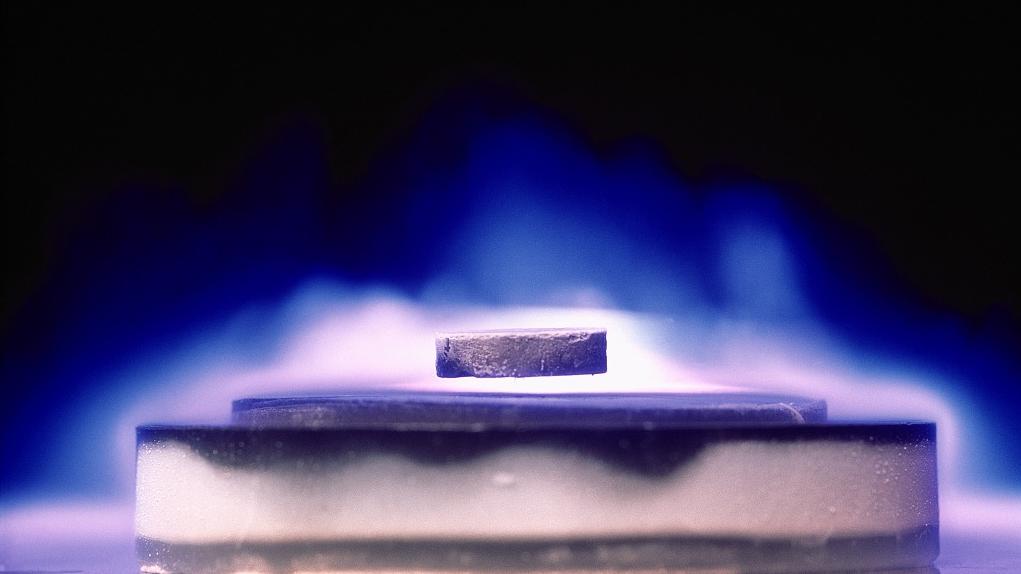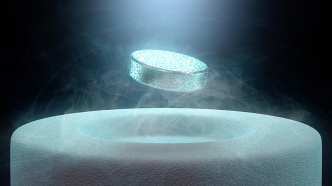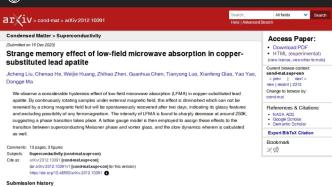

A conceptual diagram of a superconductor. Visual China Map
A major news that has caused a sensation in the scientific community recently is that the South Korean scientific research team announced that it has synthesized a room temperature superconducting material called "LK-99".
On July 22, researchers from South Korea Institute of Quantum Energy and other institutions published a paper on the preprint website arXiv saying that the "LK-99" material they synthesized has superconductivity, and the superconducting critical temperature is about 127 degrees Celsius. superconductivity at atmospheric pressure. "LK-99" is a modified lead apatite crystal structure. The South Korean research team mixed together several powdered compounds containing lead, oxygen, sulfur and phosphorus, and then heated them at high temperatures for several hours. After the powders reacted chemically, they obtained a copper-doped lead apatite crystal.
While the results announced by the South Korean team have attracted great attention from the scientific community, they have also been questioned by many scholars.
goal of science
All kinds of materials have a certain resistance at room temperature. As the electrons flow from one end of the material to the other, they continually collide and slow down, similar to how air slows down when wind blows through a leaf. In 1911, the Dutch physicist Heike Camerin Onnes found that the resistance of mercury dropped sharply at about 4 Kelvin (4 degrees Celsius above absolute zero, that is, about minus 269 degrees Celsius), entering a kind of resistance so small that it can actually be measured Not out of the new state. He called this new state of mercury a superconducting state. Onnes also won the 1913 Nobel Prize in Physics for his discovery of superconductivity.
Superconductors can only exhibit zero resistance at a specific temperature, and their two key features are zero resistance and complete diamagnetism, namely the Meissner effect. The temperature at which the resistance of a superconductor turns to zero is called the critical temperature. According to the critical temperature, superconducting materials can be divided into low-temperature superconductors and high-temperature superconductors.
So far, dozens of metallic elements—lead, mercury, niobium, tin, and their alloys—have been found to become superconductors when cooled to near absolute zero. However, the conditions for these materials to achieve superconductivity are harsh. Even the so-called "high-temperature superconductors" usually have a critical temperature of minus 100 degrees Celsius or lower, requiring liquid helium or liquid nitrogen refrigeration and high pressure, which is difficult and costly, and hardly practical. The currently confirmed world record is that researchers from the United States and Germany use lanthanum hydride materials to achieve superconductivity at 250 Kelvin (about minus 23 degrees Celsius) and an extremely high pressure of about 1 million times the atmospheric pressure.
If there is a material that can achieve superconductivity at close to room temperature and normal pressure, it will definitely bring a revolutionary breakthrough to the world. For example, computer chips can run faster and consume less energy, power grids can be close to lossless power transmission, and high-speed maglev trains may soon be put into practice... Therefore, researchers from all over the world have invested a lot of energy in this field in recent decades.
The reason why "LK-99" has attracted attention is that South Korean researchers claim that not only its critical temperature is close to normal temperature, but its composition and synthesis method are unexpectedly simple and cheap. In the past, the scientific community often sought breakthroughs in the direction of rare metal elements. Once verified and its mechanism elucidated, it may soon be close to practicality.
Whether the breakthrough needs to be verified
However, "LK-99" is not the first material to claim to achieve room temperature superconductivity. In the past, researchers have announced "major breakthroughs", but so far they have not been verified and reproduced successfully.
American researcher Langa Dias and others reported in the British journal Nature in 2020 that a compound containing carbon, sulfur, and hydrogen exhibited superconductivity at 15 degrees Celsius and became a superconductor with zero resistance. But that paper was retracted last year. On March 8 this year, another paper by the Dias team was published on the "Nature" website. The paper claimed to have developed a material containing lutetium, hydrogen, and nitrogen. Atmospheric pressure) exhibits superconducting properties, and so far, several teams have reported that they cannot reproduce their results.
What about "LK-99"? Because its preparation and verification are relatively simple, scientific research teams from many countries, including China, are trying to reproduce it.
Sinead Griffin of the Lawrence Berkeley National Laboratory in the United States published a paper on the nature of "LK-99" on the preprint website arXiv, saying that superconductivity can explain the characteristics of "LK-99", but a large number of other phenomena, such as Metal-insulator transitions, charge density waves, etc. can also be explained. In response to some media reports that her computer simulations "support the superconductivity of 'LK-99'", Griffin emphasized on social media that her paper did not provide evidence that "LK-99" has superconductivity.
The "Nature" magazine website reported on the 4th that "LK-99" was synthesized in two independent experiments conducted by teams from India's National Physical Laboratory and China's Beijing University of Aeronautics and Astronautics, but no signs of superconductivity were observed. Experiments conducted by researchers at Southeast University in China did not detect the Meissner effect, but the resistance of "LK-99" was measured to be close to zero at minus 163 degrees Celsius, which is well below room temperature and high for a superconductor. The article pointed out that the uncertainty of the structure of "LK-99" limited the researchers to draw conclusions from theoretical calculations.
The "LK-99" Verification Committee of the Korean Society for Superconductivity and Low Temperatures stated that the characteristics of the material shown in the images and papers related to "LK-99" do not conform to the Meissner effect and are not enough to prove that "LK-99" is a room temperature superconductor.
Edwin Foton, an associate professor in the Department of Materials Science and Engineering at Rensselaer Polytechnic Institute in the United States, said that achieving room temperature superconductivity requires breakthroughs in understanding the basic principles behind superconductivity, inventing new materials or discovering new ways to increase the critical temperature. Whether "LK-99" is a breakthrough or an "oolong", researchers first need to reproduce it. At present, it may take time for significant progress in the field of room temperature superconductivity.


